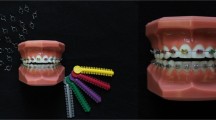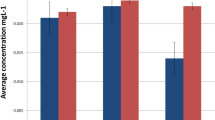Abstract
There is limited information on whether metals such as aluminum (Al) can migrate from orthodontic braces to saliva and subsequently contribute to its exposure in humans. This study aimed to assess this experimentally by incubating elastomeric orthodontic ligatures in artificial saliva for 30 days and other components of orthodontic braces (brackets, arch wires, and retainers) up to 180 days. As demonstrated, significantly higher levels of Al were leached from elastomeric ligatures (mean ± SD 28.2 ± 6.8 μg compared with their stainless steel counterparts (3.6 ± 0.1 μg) during 30 days. The higher the incubation time, the greater levels of Al leaching to artificial saliva were observed with the highest levels found for CNA β arch wire (252 ± 12 μg), Ni-Ti-Al arch wire (224 ± 11 μg), ceramic brackets (199 ± 10 μg), stainless steel arch wire (108 ± 5 μg), and metallic brackets (81.0 ± 4.2 μg) after 180 days of incubation. However, considering the tolerable weekly intake (TWI) established by the European Food Safety Authority, the intraoral use of orthodontic braces considered in this study would in the worst case constitute 0.04% and 0.09% of TWI in 70-kg adults and 30-kg children, respectively. In conclusion, the orthodontic braces considered in this study have no contribution to Al exposure in humans and can be considered safe in this regard.

Similar content being viewed by others
References
Adams D (1975) The mucus barrier and absorption through the oral mucosa. J Dent Res 54:19–26
Baty DL, Volz JE, von Fraunhofer JA (1994) Force delivery properties of colored elastomeric modules. Am J Orthod Dentofac Orthop 106:40–46
Chaturvedi TP, Upadhayay SN (2010) An overview of orthodontic material degradation in oral cavity. Indian J Dent Res 21:275–284
Cheraghi E, Golkar A, Roshanaei K, Alani B (2017) Aluminium-induced oxidative stress, apoptosis and alterations in testicular tissue and sperm quality in Wistar rats: ameliorative effects of curcumin. Int J Fertil Steril 11:166–175
Darbre PD, Mannello F, Exley C (2013) Aluminium and breast cancer: sources of exposure, tissue measurements and mechanisms of toxicological actions on breast biology. J Inorg Biochem 128:257–261
Davis WM (1993) Is aluminium an etiologic contributor to alcoholic amnesia and dementia? Med Hypotheses 41:341–343
De Broe ME, Van de Vyver FL, Silva FJ, D’Hase P, Verbueken H (1986) Measuring aluminium in serum and tissues. Overview and perspectives. Nefrologia 6(Suppl. 1):41–46
EFSA (2008) Safety of aluminium from dietary intake - scientific opinion of the panel on food additives, flavourings, processing aids and food contact materials (AFC). EFSA J 754:1–34
Eliades T, Bourauel C (2005) Intraoral aging of orthodontic materials the picture we miss and its clinical relevance. Am J Orthod Dentofac Orthop 127:403–412
Exley C (2013) Human exposure to aluminium. Environ Sci Process Impacts 15:1807–1816
Exley C (2016) The toxicity of aluminium in humans. Morphologie 100:51–55
Grochowski C, Blicharska E, Bogucki J, Proch J, Mierzwińska A, Baj J, Litak J, Podkowiński A, Flieger J, Teresiński G, Maciejewski R, Niedzielski P, Rzymski P (2019) Increased aluminum content in certain brain structures is correlated with higher silicon concentration in alcoholic use disorder. Molecules 2019, 24, 1721
Gura KM (2010) Aluminum contamination in products used in parenteral nutrition: has anything changed? Nutrition 26:585–594
Kawabata E, Dantas VL, Kato CB, Normando D (2016) Color changes of esthetic orthodontic ligatures evaluated by orthodontists and patients: a clinical study. Dental Press J Orthod 21:53–57
Kuhlman DC, Lima TA, Duplat CB, Capelli Junior J (2016) Esthetic perception of orthodontic appliances by Brazilian children and adolescents. Dental Press J Orthod 21:58–66
Lopez-Alias JF, Martinez-Gomis J, Anglada JM (2006) Ion release from dental casting alloys as assessed by a continuous flow system: nutritional and toxicological implications. Dent Mater 22:832–827
Lygre H (2002) Prosthodontic biomaterials and adverse reactions: a critical review of the clinical and research literature. Acta Odontologica Scandinavia 60:1–9
Mauro M, Crosera M, Bianco C, Bellomo F, Bovenzia M, Adami G, Filon FL (2015) In vitro permeability of silver nanoparticles through porcine oromucosal membrane. Colloids Surf B: Biointerfaces 132:10–16
Mikulewicz M, Chojnacka K, Woźniak B, Downarowicz P (2012) Release of metal ions from orthodontic appliances: an in vitro study. Biol Trace Elem Res 146:272–280
Mold M, Chmielecka A, Rodriguez MRR, Thom F, Linhart C, King A, Exley C (2018a) Aluminium in brain tissue in multiple sclerosis. Int J Environ Res Public Health 18:15(8)
Mold M, Umar D, King A, Exley C (2018b) Aluminium in brain tissue in autism. J Trace Elem Med Biol 46:76–82
Olszewska A, Hańc A, Barałkiewicz D, Rzymski P (2019) Metals and Metalloids Release from Orthodontic Elastomeric and Stainless Steel Ligatures: In Vitro Risk Assessment of Human Exposure. Biol Trace Elem Res. https://doi.org/10.1007/s12011-019-01936-8
Rondeau V, Commenges D, Jacqmin-Gadda H, Dartigues J-F (2000) Relation between aluminum concentrations in drinking water and Alzheimer’s disease: an 8-year follow-up study. Am J Epidemiol 152:59–66
Rosenlöf K, Fyhrquist F, Tenhunen R (1990) Erythropoietin, aluminium, and anaemia in patients on haemodialysis. Lancet 335:247–249
Russ TC, Killin LOJ, Hannah J, Batty GD (2019) Aluminium and fluoride in drinking water in relation to later dementia risk. Brit J Psychiatry doi. https://doi.org/10.1192/bjp.2018.28
Rzymski P, Budzulak J, Niedzielski P, Klimaszyk P, Proch J, Kozak L, Poniedziałek B (2019) Essential and toxic elements in commercial microalgal food supplements. J Appl Phycol 31:3567–3579
Rzymski P, Niedzielski P, Kaczmarek N, Jurczak T, Klimaszyk P (2015) The multidisciplinary approach to safety and toxicity assessment of microalgae-based food supplements following clinical cases of poisoning. Harmful Algae 46:34–42
Squier CA (1991) The permeability of oral mucosa. Crit Rev Oral Biol Med 2:13–32
Taloumis LJ, Smith TM, Hondrum SO, Lorton L. (1997) Force decay and deformation of orthodontic elastomeric ligatures. Am J Orthod Dentofac Orthop 111:1–11
Taylor GA, Moore PB, Ferrier IN, Tyrer SP, Edwardson JA (1998) Gastrointestinal absorption of aluminium and citrate in man. J Inorg Biochem 69:165–169
Yokel RA, McNamara PJ (2001) Aluminium toxicokinetics: an updated minireview. Pharmacol Toxicol 88:159–167
Yuan CY, Lee YJ, Hsu GS (2012) Aluminum overload increases oxidative stress in four functional brain areas of neonatal rats. J Biomed Sci 19:51
Zhang H, Tang J, Huang L, Shen X, Zhang R, Chen J (2016) Aluminium in food and daily dietary intake assessment from 15 food groups in Zhejiang Province. China Food Addit Contam Part B Surveill 9:73–78
Author information
Authors and Affiliations
Corresponding author
Ethics declarations
Conflict of interest
The authors declare that they have no conflict of interest.
Additional information
Responsible editor: Philippe Garrigues
Publisher’s note
Springer Nature remains neutral with regard to jurisdictional claims in published maps and institutional affiliations.
Rights and permissions
About this article
Cite this article
Olszewska, A., Hańć, A., Barałkiewicz, D. et al. The contribution of orthodontic braces to aluminum exposure in humans: an experimental in vitro study. Environ Sci Pollut Res 27, 4541–4545 (2020). https://doi.org/10.1007/s11356-019-07083-w
Received:
Accepted:
Published:
Issue Date:
DOI: https://doi.org/10.1007/s11356-019-07083-w




